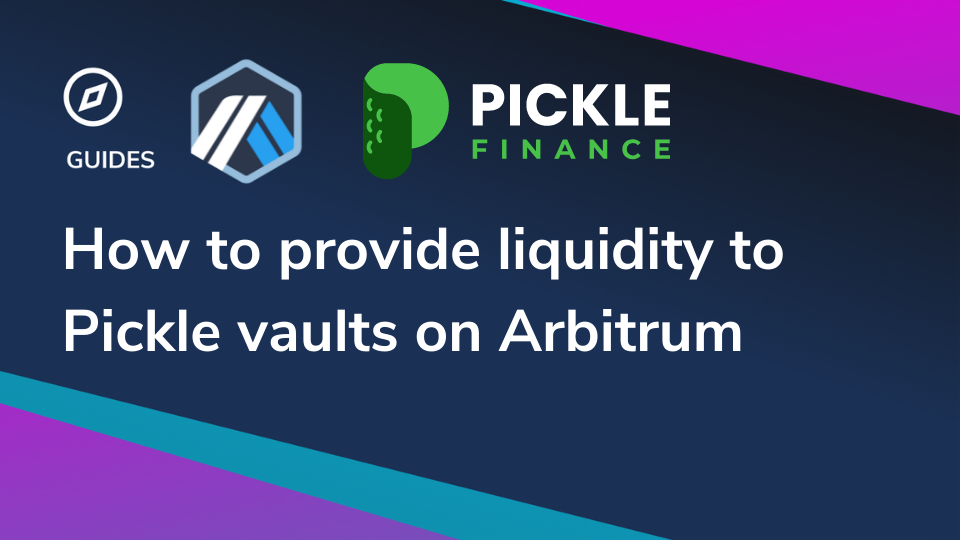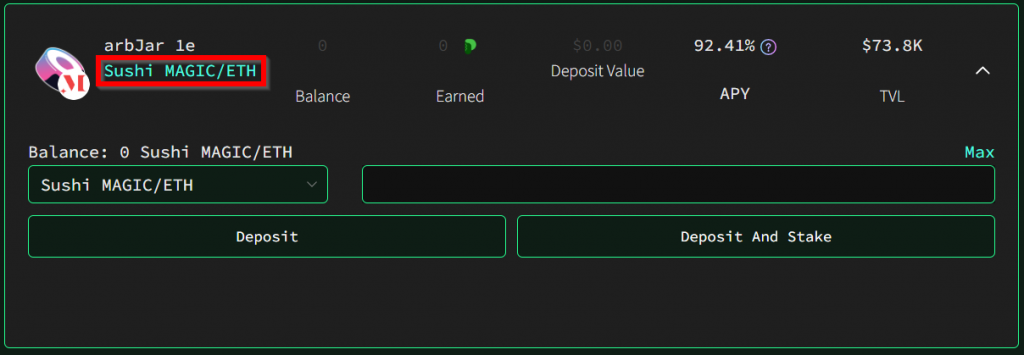How to provide liquidity to Pickle Finance Vaults on Arbitrum

In this guide we will explain how to provide liquidity to Pickle vaults on the Arbitrum network to earn swap fees and yield farming rewards that are auto-compounded.
What is Pickle Finance?
Pickle Finance is a “yield aggregator” which aggregates and compounds yield from other protocols. Yield aggregators exist for yield farmers who want to invest money and maximize profits by leveraging different DeFi protocols and strategies for elevated returns.
Pickle Finance makes it simple for users to earn compounding yields on deposits when they don’t have the time to compound it daily or the gas fee is too high for frequent compounding to be done. Pickle Finance is always on the lookout for opportunities to generate yield on assets for all risk tolerance levels.
What is Arbitrum?
Arbitrum is a suite of Ethereum scaling solutions that enables high-throughput, low cost smart contracts while remaining trustlessly secure. Arbitrum has three modes: AnyTrust Channels, AnyTrust Sidechains, and Arbitrum Rollup. Arbitrum Rollup is an Optimistic Rollup protocol designed for the Ethereum blockchain. Compared to other Rollup approaches, Arbitrum Rollup’s design shines in that the amount of data on chain is quite low, and it can support arbitrary EVM smart contracts and works with all Ethereum developer tooling. You can explore the ecosystem by visiting the Arbitrum One Portal.
What you will need to provide liquidity Pickle on Arbitrum
- Metamask wallet
- ETH tokens in your Arbitrum wallet for gas
- Tokens to deposit into a Balancer pool (or tokens you can use to swap into the tokens needed for a given pool)
Setting up the Arbitrum network with your Metamask wallet to use Pickle
First, you will need to configure your Metamask wallet to connect to the Arbitrum network. You will need to open Metamask and click on the Network selection dropdown and then click on Custom RPC.
Here is the list of the parameters so you can easily copy them:
- Network Name: Arb1
- RPC: https://arb1.arbitrum.io/rpc
- Chain ID: 42161
- Currency Symbol: ETH
- Block Explorer URL: https://arbiscan.io
Fill out the empty fields with the data above and click on Save. You will be directly switched to Arbitrum’s Mainnet now in the network dropdown list. This process adds the Arbitrum network to the list of available networks you can switch to from within Metamask. Sometimes it is helpful to switch networks when Metamask is acting strange or if you are having trouble getting things to show up.
After you have set up Metamask to connect to Arbitrum, you can then connect to the Uniswap app. Select “Arb1” from the list of networks in the top right and then you can begin interacting with Uniswap.
RESOURCE: Use Chainlist.wtf to get details for any chains supported by Metamask!
Move funds from ETH network to Arbitrum network
The safest way to move funds over to Arbitrum is directly from the Ethereum network using the Arbitrum Bridge pictured below.
- One very important thing to note is that withdrawals from Arbitrum can take 1 week!
- APY.vision has a new Bridge tool that can help you find paths between many different chains
Finding the right Vault to provide liquidity to on Pickle
Pickle has a variety of options on their platform ranging from vaults that require LP tokens via an AMM to deposit all the way to single asset vaults that only require depositing one type of token. You can use the filters at the top of the page to narrow your selection by criteria like which AMM or lending platform.
Platforms: Curve, SushiSwap, DODO, Balancer, Stargate
Vault types: Single Asset, LP tokens
You can check which individual vaults are supported by APY.vision here.
Steps to add liquidity to Pickle vaults

Step 1: Identify which vault you would like to deposit to and make sure you have either the single token or LP tokens needed to deposit. For more info on how to add liquidity to AMM’s to get the LP tokens, you can check out this article that offers a guide on supplying liquidity to Sushiswap on Arbitrum. If you do not already have the LP token, you can click the “Sushi MAGIC/ETH” link highlighted above to navigate to SushiSwap where you can deposit liquidity into the pool.
NOTE: Pickle has added a new feature to support depositing single assets into the vault allowing users to bypass going to a DEX to get LP tokens before entering a vault! There is a drop down menu just below the highlighted area that enables this feature. In this case you would need either ETH, WETH, or MAGIC and you can bypass the LP token acquisition step of the process.
If you do not have the tokens required for the pool, you can use the “Swap” function of SushiSwap to trade for them. Once you have the 50/50 proportion of both tokens you can then use the “Confirm Adding Liquidity” link to deposit the tokens into the AMM (Sushiswap in this example) liquidity pool to get the LP tokens needed. The process for adding liquidity can vary from protocol to protocol, check our blog archives for guides on how to use many of them.
Once you have entered the liquidity pool, you can manage your position on SushiSwap by navigating to the “Pool” section of the application. You do NOT need to stake those LP tokens on Sushiswap as Pickle will be doing that for you.
Once you have the LP tokens needed, Click the “Deposit” button and confirm the transaction. If you want to combine the deposit and stake functions, there is a button to the right that will automatically trigger the staking transaction directly after depositing.
Now that you have deposited the LP tokens, in order to earn PICKLE rewards you will then have to stake your tokens. If you hover over the “?” icon near the APY it will tell you what the PICKLE rewards for that vault will be.
Tracking Your Position on APY.vision
First time APY.vision users – enter your Polygon address in the box highlighted above. On mobile/tablets click on the search icon and copy their address into the popup
Once your vault position is deposited and auto-compounding on Pickle, you can start tracking the performance of the vault. APY.vision will separate the liquidity pool activity from the vault activity (the auto compounding) as shown above.
How to withdraw and what to expect
Right now all of the jars in Pickle.finance have a 20% Performance fee on profits. The fees are automatically sent to the Treasury when the harvest bot reinvests the strategy. There are no withdrawal fees.
When you are ready to pull your liquidity from the vault, enter the amount you wish to withdraw (or hit the “Max” button to automatically select the entire balance) and hit the “Harvest and Exit” button and your LP tokens will be back in your wallet. To exit the liquidity pool entirely, you will have to go back to the AMM (SushiSwap) where you entered into the pool to get your tokens back. Note you only need to do this if you are in a vault using LP tokens, a single asset vault will not require these extra steps.
Pictured above is the “Pool” section on SushiSwap where you can find the option to remove your liquidity from the pool.
Conclusion
Providing liquidity is a great way to earn some income on tokens sitting in your wallet. You do have to be careful when providing liquidity, as sharp price increases or decreases can have a huge impact on the performance of your position. To read more about the risks, we highly recommend reading this post. We suggest using APY.Vision to keep a close eye on your positions to know when to remove liquidity during times of extreme price volatility.
APY.Vision does not give investment advice and always insists that you do your own research. Read our full Legal Disclaimer.
Check out APY.Vision!
APY.Vision is an advanced analytics tool for liquidity pool providers and yield farmers. If you’re using any DEXs, AMMs, or liquidity pools this is the tool you will need to easily track the ROI of your liquidity provider and yield farming activities. Try it now!
